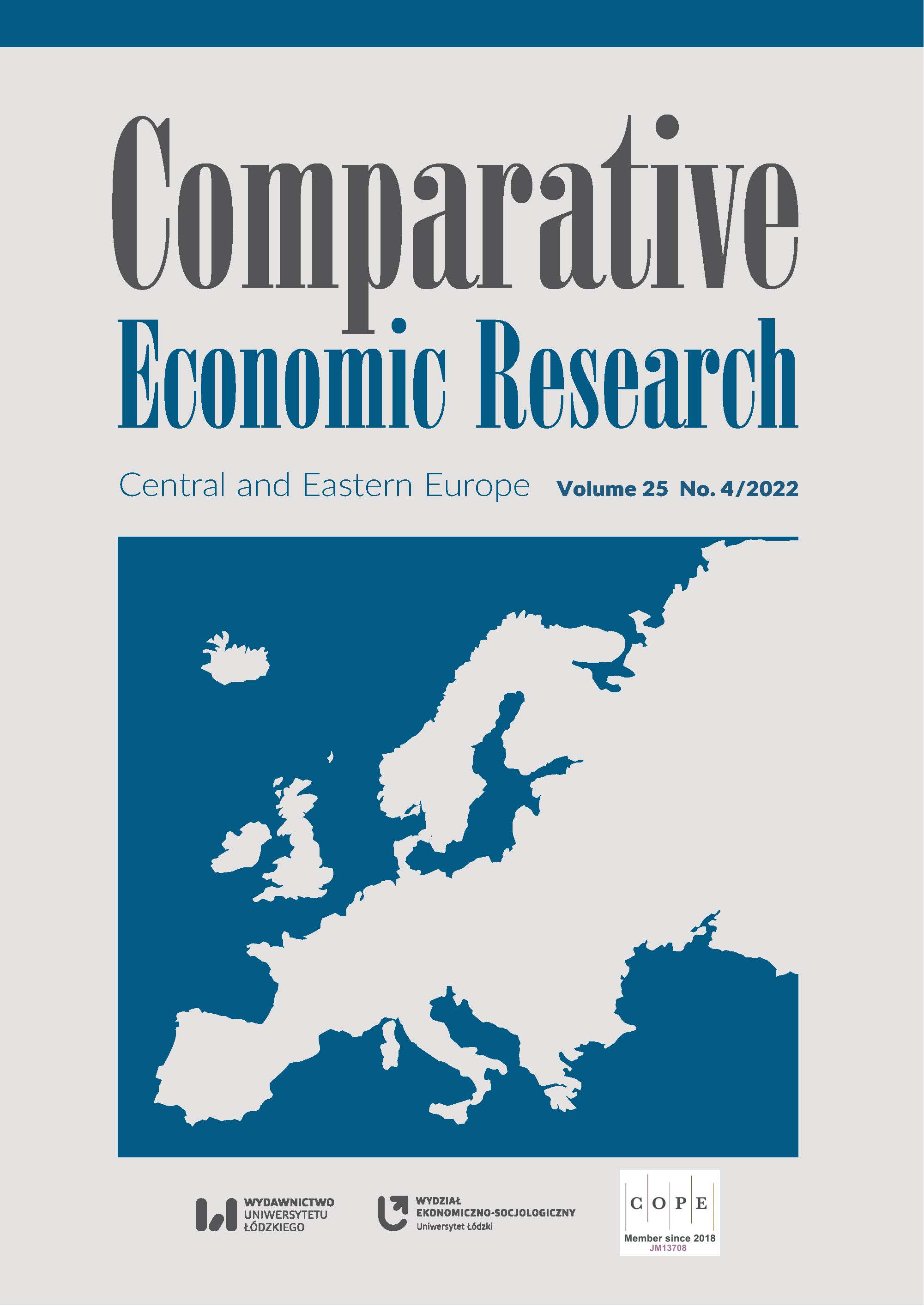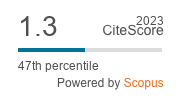Public Debt Management Experience: The Case of EECCA Countries
DOI:
https://doi.org/10.18778/1508-2008.25.30Keywords:
internal debt, external debt, debt management, public debt management tools, developing economiesAbstract
The aim of this study is to cluster the most widely used public debt management tools peculiar to the EECCA (Eastern Europe, Caucasus, and Central Asia) markets. Overall, the results show that the volume of EECCA countries’ public debt relative to GDP declined from 2000 to 2015. However, as their public debt enhanced after 2016 and until 2020, inclusive, the need to choose proper tools for its management intensified. The main cause of public debt in most EECCA countries is the state budget deficit (Kazakhstan, Kyrgyzstan, Moldova, Russia, Tajikistan, Uzbekistan). The second place was taken by the balance of payments deficit (Armenia, Belarus). The only unique country was Azerbaijan, since it is likely to use public debt to finance economic and infrastructure development projects. No less interesting is that not all EECCA member states generate internal public debt. Kyrgyzstan, Moldova, and Uzbekistan have external public debt exclusively due to the lack of free resources that can be attracted from within the economy. In general, the investigation revealed that the main tool for managing internal public debt in EECCA countries is public bonds issued in national and foreign currencies. As for external public debt management, the top position is taken by external public bonds and international loans. The study has only two limitations: methodological and implementation. Other macroeconomic indicators of economic development were not considered, even though they may change the assessment of the effectiveness of the selected tools of public debt management. Meanwhile, the results can only be applied to those countries whose financial market is already formed and who have access to international financial markets. Otherwise, the tools of public debt management are limited.
Downloads
References
Anokhov, D. (2020), Research Report on Belarus, Raexpert, https://raexpert.eu/reports/Research_report_Belarus_10.07.2020.pdf (accessed: 2.09.2021).
Google Scholar
Belyakov, I. (2017), Prospects of Demand for Russia’s Ruble-Denominated Debt, “Financial Journal”, 1, pp. 39–51, https://ideas.repec.org/a/fru/finjrn/170103p39-51.html (accessed: 2.09.2021).
Google Scholar
Dayneko, A. (2017), Foreign borrowings and macroeconomic balance in Belarus, “Bank Bulletin”, 2017, pp. 33–38, https://elibrary.ru/item.asp?id=37206715 (accessed: 2.09.2021) [in Russian].
Google Scholar
Ministry of Finance of the Republic of Belarus (2021a), Government bonds denominated in foreign currency on the domestic financial market, http://www.minfin.gov.by/ru/public_debt/bonds/postedissues/doc/ (accessed: 2.09.2021) [in Russian].
Google Scholar
Ministry of Finance of the Republic of Belarus (2021b), Government bonds of the Republic of Belarus placed on foreign financial markets, http://www.minfin.gov.by/upload/gosdolg/vneshniy/evrobonds_new.pdf (accessed: 2.09.2021) [in Russian].
Google Scholar
Ministry of Finance of the Republic of Belarus (2021c), On public debt of the Republic of Belarus, http://www.minfin.gov.by/upload/gosdolg/publication/report_2020.pdf (accessed: 2.09.2021) [in Russian].
Google Scholar
Ministry of Finance of the Republic of Belarus (2021d), Public debt of the Republic of Belarus, http://www.minfin.gov.by/ru/public_debt/condition/archive/ (accessed: 2.09.2021) [in Russian].
Google Scholar
Ministry of Finance of the Republic of Tajikistan (2021), Public debt, http://minfin.tj/index.php?do=static&page=gosdolg (accessed: 2.09.2021) [in Russian].
Google Scholar
Ministry of Finance of the Republic of Uzbekistan (2021), The review of the state and dynamics of the public debt of the Republic of Uzbekistan, https://www.imf.org/-/media/Files/Publications/CR/2022/Russian/1UZBRA2022001.ashx (accessed: 2.09.2021) [in Russian].
Google Scholar
Ministry of Finance of the Russian Federation (2021a), Central directions of the public debt policy of the Russian Federation for 2017–2019, https://minfin.gov.ru/ru/perfomance/public_debt/policy/?id_39=117428-osnovnye_napravleniya_gosudarstvennoi_dolgovoi_politiki_rossiiskoi_federatsii_na_2017-2019_gg (accessed: 2.09.2021) [in Russian].
Google Scholar
Ministry of Finance of the Russian Federation (2021b), Domestic debt by type of securities, https://minfin.gov.ru/ru/perfomance/public_debt/internal/structure/duty/ (accessed: 2.09.2021) [in Russian].
Google Scholar
Ministry of Finance of the Russian Federation (2021c), Public debt of the Russian Federation in 2013–2019, https://minfin.gov.ru/ru/perfomance/public_debt/policy/ (accessed: 2.09.2021) [in Russian].
Google Scholar
Ministry of Finance Republic of Azerbaijan (2021), External debt, http://www.maliyye.gov.az/en/search/index?search=debt (accessed: 2.09.2021) [in Russian].
Google Scholar
Misereor (2020), Global sovereign debt monitor, https://www.misereor.org/fileadmin/user_upload_misereororg/publication/en/shaping_economic_processes/global-sovereign-debt-monitor-2020.pdf (accessed: 2.09.2021).
Google Scholar
National Bank of Moldova (2021), Public debt, https://www.bnm.md/ru/search?search_name=государственный%20долг (accessed: 2.09.2021) [in Russian].
Google Scholar
National Statistical Committee of the Kyrgyz Republic (2021), Public debt, http://www.stat.kg/ru/opendata/category/34/ (accessed: 2.09.2021) [in Russian].
Google Scholar
Parasotskaya, N.N., Yakovlev, N.D. (2019), Pros and cons of public borrowing and public debt for the Russian budget system, “Accounting. Analysis. Auditing”, 6 (4), pp. 61–69, https://doi.org/10.26794/2408-9303-2019-6-4-61-69 [in Russian].
Google Scholar
DOI: https://doi.org/10.26794/2408-9303-2019-6-4-61-69
Statistical Committee of the Republic of Armenia (2021), Publications by year, https://www.armstat.am/ru/?nid=82&year=2020 (accessed: 2.09.2021) [in Russian].
Google Scholar
The Agency of the Republic of Kazakhstan for Regulation and Development of Financial Market (2021), External Debt, https://www.gov.kz/memleket/entities/ardfm/press/article/details/59315?lang=ru (accessed: 2.09.2021) [in Russian].
Google Scholar
The World Bank (2021), Central government debt, https://data.worldbank.org/indicator/GC.DOD.TOTL.GD.ZS?locations=AZ-BY-KZ-KG-MD-RU-TJ-UZ (accessed: 2.09.2021).
Google Scholar
Tsvirko, S.E. (2014), Problems of public debt management system in Russia, https://www.jsdrm.ru/jour/article/view/199?locale=ru_RU (accessed: 2.09.2021) [in Russian].
Google Scholar
United Nations (2021), World Economic Situation and Prospects: Economies in Transition, https://www.un.org/development/desa/dpad/wp-content/uploads/sites/45/WESP2021_CH3_EIT.pdf (accessed: 2.09.2021).
Google Scholar
Vilkova, S.G., Cheplakova, P.Yu. (2017), Analysis of structure and dynamics of national debt of Russian Federation, “Bulletin of the Samara Municipal Institute of Management”, 2, pp. 106–114, https://www.imi-samara.ru/wp-content/uploads/2017/03/Vilkova_Cheplakova_106-114-.pdf (accessed: 2.09.2021) [in Russian].
Google Scholar
Downloads
Published
How to Cite
Issue
Section
License

This work is licensed under a Creative Commons Attribution-NonCommercial-NoDerivatives 4.0 International License.











